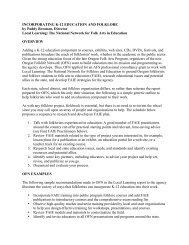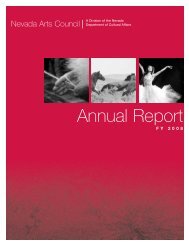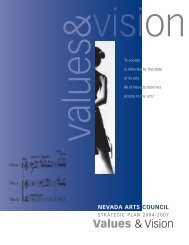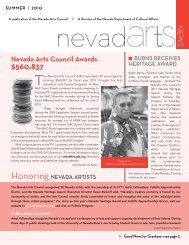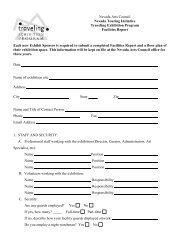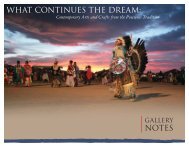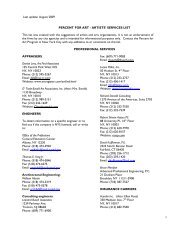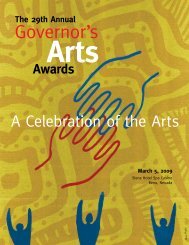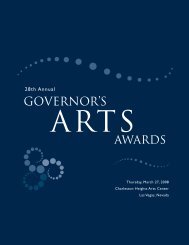Handed Down - Nevada Arts Council
Handed Down - Nevada Arts Council
Handed Down - Nevada Arts Council
Create successful ePaper yourself
Turn your PDF publications into a flip-book with our unique Google optimized e-Paper software.
1989–1990<br />
Saddlemaking:<br />
Eddie Brooks and Alan McDonald<br />
Saddle maker Eddie Brooks is a transplanted Texan<br />
whose roots have grown deep into the buckaroo<br />
country around Elko. He started working with leather<br />
as a boy growing up around Ft. Worth, making belts,<br />
wallets and other small items, and eventually apprenticed<br />
in the saddle making trade that supports him today.<br />
He was running a Texas saddle shop in 1964 when<br />
Paul Bear from Capriola’s in Elko hired him away. He<br />
worked in <strong>Nevada</strong> for two years, then returned to Texas<br />
for another nine years, but came back to Elko for good<br />
in 1975.<br />
“I never could get this country out of my system,<br />
I loved it up here,” he says. He was struck by the<br />
differences in the way cattle were worked, too, and<br />
consequently the different saddle styles in each region<br />
of the country. He says the move to <strong>Nevada</strong> “was really<br />
good for me, made a lot better saddle maker out of<br />
me…When I come up here, well, they really, they sit in<br />
them all day long. Back then, this country, there wasn’t<br />
a fence in the country hardly, you could ride plumb to<br />
Idaho and never hit a fence from Elko. They’ve fenced<br />
it up a lot now, and that’s just twenty something years<br />
ago. So they went everywhere horseback, you know,<br />
and there wasn’t a stock trailer in the country in them<br />
days. They had a few bob-tail trucks and if they had to<br />
go 100 miles they’d haul their horses, but if they had to<br />
go 30 miles they rode. So they really demanded a good<br />
saddle…It really helped me. I wouldn’t take nothing<br />
for it, cause it made such a difference.” Eddie ran the<br />
shop at Capriola’s until 1982, and then started his own<br />
custom saddle business.<br />
Eddie’s apprentice Alan McDonald was raised in<br />
a ranching family in southern Idaho. His father was<br />
also a saddle maker, and Alan inherited his tools and<br />
his love for cowboying. “I figured, well, cowboying is<br />
basically my main interest in life, it still is pretty much,<br />
so I just loaded up my saddle…well, I didn’t have a<br />
saddle, I needed a saddle. So I decided, well, I’ll build<br />
me one. So I did, I kind of got one put together, come<br />
to <strong>Nevada</strong>, and started cowboying on it, been riding it<br />
for about five years. It was pretty crude, but I got my<br />
riggings in straight and it fit a horse pretty good, but it<br />
didn’t always fit me too good so I was always taking it<br />
apart and cutting on it somewhere and putting it back<br />
together…I’ve always held the interest, wanted to learn.<br />
Eddie Brooks and<br />
Alan McDonald in<br />
Eddie’s Spring Creek<br />
saddle shop.<br />
Alan McDonald uses<br />
the saddle he made while<br />
working as a buckaroo<br />
on the IL Ranch in<br />
northern Elko County.<br />
I’d go into saddle shops and try to watch guys work. A<br />
lot of guys will quit working when you go in, you know,<br />
so you just kind of got to walk around and try to pick<br />
things up, but I’d never had any formal instruction until<br />
last winter.”<br />
Fortunately for Alan, Eddie was willing to let him<br />
watch and learn, and Alan built a complete saddle during<br />
his apprenticeship. He still works as a buckaroo—<br />
“For me, the more hours you spend in a saddle, that’s<br />
experience towards building them,” he says—and<br />
would like to keep riding as long as he can, but he will<br />
also be developing his saddle making and silver working<br />
skills, too, as a lifelong trade. Eddie and Alan agree that<br />
the most important part of saddle making is to fit the<br />
horse, and then to fit the rider. But as Alan says, “Then,<br />
you know, in the end you want a product that looks<br />
balanced, that the lines are together on it. That’s where<br />
the pride in your craftsmanship comes in.”<br />
10




